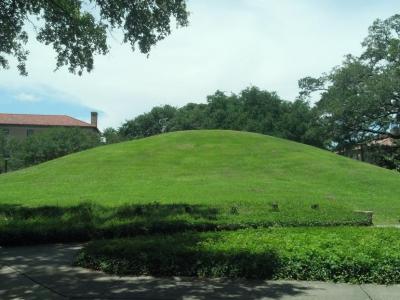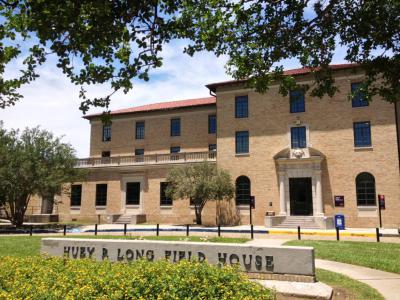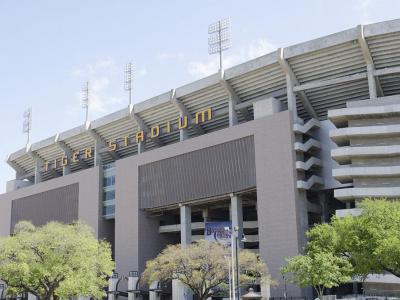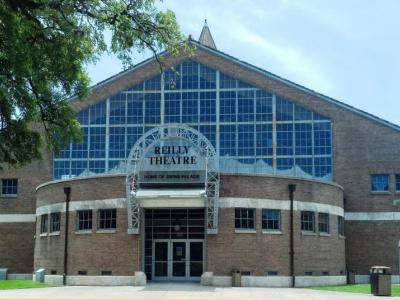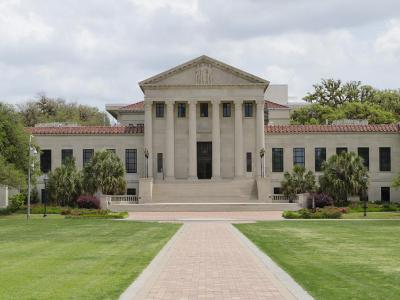
Louisiana State University Walking Tour (Self Guided), Baton Rouge
Louisiana State University is the flagship university of the LSU system. It was originally founded in Pineville in 1860 as a seminary and military academy. The present campus in Baton Rouge was established in 1926.
The LSU campus is noted for its architecture and historical center. The campus has 250 buildings designed in the Italian Renaissance style. Among these are the Memorial Tower, Hill Memorial Library, and the Paul M. Hebert Law Center.
LSU is arguably best known for its athletics program. The LSU Tigers play in the NCAA and have won 50 national titles. The campus shows great pride in its tigers through its live mascot, Mike the Tiger. Mike has his own habitat that can be visited by campus visitors.
The Indian Mounds on the LSU campus are thought to be among the oldest man-made structures in the world. Though there is some dispute, most experts agree they were built roughly 5,000 years ago. Visitors to the LSU campus can walk between and around these mounds, which are located near the LSU Main Library and the LSU Museum of Natural Science.
Take this self-guided walking tour to see many of the most notable places on the Louisiana State University campus.
The LSU campus is noted for its architecture and historical center. The campus has 250 buildings designed in the Italian Renaissance style. Among these are the Memorial Tower, Hill Memorial Library, and the Paul M. Hebert Law Center.
LSU is arguably best known for its athletics program. The LSU Tigers play in the NCAA and have won 50 national titles. The campus shows great pride in its tigers through its live mascot, Mike the Tiger. Mike has his own habitat that can be visited by campus visitors.
The Indian Mounds on the LSU campus are thought to be among the oldest man-made structures in the world. Though there is some dispute, most experts agree they were built roughly 5,000 years ago. Visitors to the LSU campus can walk between and around these mounds, which are located near the LSU Main Library and the LSU Museum of Natural Science.
Take this self-guided walking tour to see many of the most notable places on the Louisiana State University campus.
How it works: Download the app "GPSmyCity: Walks in 1K+ Cities" from Apple App Store or Google Play Store to your mobile phone or tablet. The app turns your mobile device into a personal tour guide and its built-in GPS navigation functions guide you from one tour stop to next. The app works offline, so no data plan is needed when traveling abroad.
Louisiana State University Walking Tour Map
Guide Name: Louisiana State University Walking Tour
Guide Location: USA » Baton Rouge (See other walking tours in Baton Rouge)
Guide Type: Self-guided Walking Tour (Sightseeing)
# of Attractions: 10
Tour Duration: 2 Hour(s)
Travel Distance: 3.4 Km or 2.1 Miles
Author: jenny
Sight(s) Featured in This Guide:
Guide Location: USA » Baton Rouge (See other walking tours in Baton Rouge)
Guide Type: Self-guided Walking Tour (Sightseeing)
# of Attractions: 10
Tour Duration: 2 Hour(s)
Travel Distance: 3.4 Km or 2.1 Miles
Author: jenny
Sight(s) Featured in This Guide:
- Memorial Tower
- LSU Library
- Hill Memorial Library
- The Indian Mounds
- Huey P. Long Field House
- Mike the Tiger Habitat
- Tiger Stadium
- Swine Palace
- LSU Student Union
- Paul M. Hebert Law Center
1) Memorial Tower
Memorial Tower is a clock tower on the Louisiana State University campus. The 175-foot structure, also called the Campanile (Bell Tower), is a memorial to Louisianans who died in World War I. The tower's interior hosts a small military museum.
Construction of the tower began in 1923 and was completed in 1926. It was designed in the Italian Renaissance architectural style by architect Theodore Link. The design includes bronze plaques etched with the names of nearly 1,500 fallen soldiers.
Memorial Tower is an icon for the Louisiana State University campus. The chimes ring every quarter hour until 10 PM. At noon, the chimes ring out with the alma mater. Tradition states that an LSU student can only become a "true LSU student" if they are kissed under the tower on Valentine's Day when the chimes ring at midnight.
The plaza in front of Memorial Tower is often used for campus-wide celebrations. It is a popular spot for photography, especially when the holiday lights are on grand display.
Construction of the tower began in 1923 and was completed in 1926. It was designed in the Italian Renaissance architectural style by architect Theodore Link. The design includes bronze plaques etched with the names of nearly 1,500 fallen soldiers.
Memorial Tower is an icon for the Louisiana State University campus. The chimes ring every quarter hour until 10 PM. At noon, the chimes ring out with the alma mater. Tradition states that an LSU student can only become a "true LSU student" if they are kissed under the tower on Valentine's Day when the chimes ring at midnight.
The plaza in front of Memorial Tower is often used for campus-wide celebrations. It is a popular spot for photography, especially when the holiday lights are on grand display.
2) LSU Library
The LSU Library is the main library of Louisiana State University. Along with books, the library contains government documents, music resources, and oral histories.
The historic library on the LSU campus is the Hill Memorial Library. The LSU Library was built in 1959 to provide more space for volumes and recordings. Hill Memorial Library now holds the library's special collections.
The library building was designed by the architectural firm Bodman, Murrell & Smith. The interior of the modern building contains photographs of the library while it was under construction. Visitors can also see early drawings of the structure.
The LSU Library was previously named for Troy H. Middleton, who served as president of LSU from 1951 to 1962. Middleton's name was removed from the library in 2020. When he served as president, he strongly opposed the integration of the campus.
Unlike many university libraries, the LSU library is open to the general public. Visitors may check out books for up to 10 days.
The historic library on the LSU campus is the Hill Memorial Library. The LSU Library was built in 1959 to provide more space for volumes and recordings. Hill Memorial Library now holds the library's special collections.
The library building was designed by the architectural firm Bodman, Murrell & Smith. The interior of the modern building contains photographs of the library while it was under construction. Visitors can also see early drawings of the structure.
The LSU Library was previously named for Troy H. Middleton, who served as president of LSU from 1951 to 1962. Middleton's name was removed from the library in 2020. When he served as president, he strongly opposed the integration of the campus.
Unlike many university libraries, the LSU library is open to the general public. Visitors may check out books for up to 10 days.
3) Hill Memorial Library
Hill Memorial Library is the historical library on the Louisiana State University campus. It was the first library built for LSU in 1903. John Hill, Sr., a Scottish-born sugar planter, provided funding for the library in memory of his son, John Hill, Jr.
Before Hill Memorial Library was built, the library operated in a powder magazine of a former U.S. Arsenal. The newly built library housed 60,000 volumes and had seating for 375 students. Within 30 years, the library had more than 200,000 volumes, which required additional library branches on campus.
Many volumes and manuscripts were removed from Hill Memorial Library in the mid-20th century when the new Louisiana State University Library was built. Hill Memorial Library became home to the LSU press and the architecture department. It also held a psychology clinic and a photocopying center.
In the 1980s, Hill Memorial Library was reorganized to hold special collections, which required massive renovations, including climate control, a new gallery space, and a lecture hall. Some unique and rare collections at Hill Memorial Library are several books from the first 50 years of printing, an atlas by Ptolemy, first editions from John Donne, and a Second Folio edition of Shakespeare's plays, printed in 1632.
Before Hill Memorial Library was built, the library operated in a powder magazine of a former U.S. Arsenal. The newly built library housed 60,000 volumes and had seating for 375 students. Within 30 years, the library had more than 200,000 volumes, which required additional library branches on campus.
Many volumes and manuscripts were removed from Hill Memorial Library in the mid-20th century when the new Louisiana State University Library was built. Hill Memorial Library became home to the LSU press and the architecture department. It also held a psychology clinic and a photocopying center.
In the 1980s, Hill Memorial Library was reorganized to hold special collections, which required massive renovations, including climate control, a new gallery space, and a lecture hall. Some unique and rare collections at Hill Memorial Library are several books from the first 50 years of printing, an atlas by Ptolemy, first editions from John Donne, and a Second Folio edition of Shakespeare's plays, printed in 1632.
4) The Indian Mounds
The Indian Mounds at Louisiana State University are two Native American mounds thought to be more than 5,000 years old. They are considered the oldest surviving human-made structures in the Americas. Some believe the mounds are over 11,000 years old, which makes them the oldest surviving human-made structures in the world.
The mounds are 20 feet tall and take up a space of two acres. They were built overlooking the Mississippi River and were used for ceremonial purposes rather than for burial. However, some experts have suggested that cremated human remains were placed within the mounds due to the presence of ancient charcoal.
The mounds have been damaged over the years due to human traffic and natural erosion. Preservation attempts against human interference include placing sidewalks between the structures, building low brick walls between them, and fencing them during LSU games. Preservation attempts against natural erosion include rebuilding portions of the mounds with river silt and seeding with Bermuda grass.
The Indian Mounds are on the U.S. National Register of Historic Places.
The mounds are 20 feet tall and take up a space of two acres. They were built overlooking the Mississippi River and were used for ceremonial purposes rather than for burial. However, some experts have suggested that cremated human remains were placed within the mounds due to the presence of ancient charcoal.
The mounds have been damaged over the years due to human traffic and natural erosion. Preservation attempts against human interference include placing sidewalks between the structures, building low brick walls between them, and fencing them during LSU games. Preservation attempts against natural erosion include rebuilding portions of the mounds with river silt and seeding with Bermuda grass.
The Indian Mounds are on the U.S. National Register of Historic Places.
5) Huey P. Long Field House
The Huey P. Long Field House is the original student union for the Louisiana State University campus. It was named for notable U.S. Senator and state governor Huey Long.
The building was designed in the Italian Renaissance architectural style by the architecture firm of Weiss, Dreyfous & Seiferth. Construction was completed in 1932. The Huey P. Long Field House contained the largest swimming pool in the United States at the time it was built.
The field house's swimming pool and multi-purpose gymnasium were primarily built for the swimming, diving, hockey, and boxing teams. Along with its athletic facilities, the field house had a post office and ballroom. The athletic departments eventually outgrew the field house and left it vacant by the late 20th century.
Renovation on the field house took place in 2020 under the direction of architecture firm Tipton Associates. The building is currently the home of LSU's Department of Kinesiology and School of Social Work.
The building was designed in the Italian Renaissance architectural style by the architecture firm of Weiss, Dreyfous & Seiferth. Construction was completed in 1932. The Huey P. Long Field House contained the largest swimming pool in the United States at the time it was built.
The field house's swimming pool and multi-purpose gymnasium were primarily built for the swimming, diving, hockey, and boxing teams. Along with its athletic facilities, the field house had a post office and ballroom. The athletic departments eventually outgrew the field house and left it vacant by the late 20th century.
Renovation on the field house took place in 2020 under the direction of architecture firm Tipton Associates. The building is currently the home of LSU's Department of Kinesiology and School of Social Work.
6) Mike the Tiger Habitat (must see)
Mike the Tiger is the official mascot of the LSU Tigers. Mike the Tiger lives on campus in the Mike the Tiger Habitat. There has been a Mike the Tiger on the LSU campus since 1936.
The first Mike lived in a habitat that was 2,000 square feet. It had a building enclosure and climbing logs for the Mikes to enjoy over the years.
The new habitat, designed by Torre Design Consortium LTD, was built in 2005. The current Mike has a 15,000-square-foot habitat. It includes a waterfall, a wading pond, and climbing rocks.
The $3 million for habitat was mainly paid by donations. Those visiting the habitat will see a brick walkway with the names of many of the donors. The habitat offers educational, interpretive, and recreational activities. It also has conservation, research, and husbandry programs.
The first Mike lived in a habitat that was 2,000 square feet. It had a building enclosure and climbing logs for the Mikes to enjoy over the years.
The new habitat, designed by Torre Design Consortium LTD, was built in 2005. The current Mike has a 15,000-square-foot habitat. It includes a waterfall, a wading pond, and climbing rocks.
The $3 million for habitat was mainly paid by donations. Those visiting the habitat will see a brick walkway with the names of many of the donors. The habitat offers educational, interpretive, and recreational activities. It also has conservation, research, and husbandry programs.
7) Tiger Stadium (must see)
Tiger Stadium is an outdoor stadium located in Baton Rouge, on the campus of Louisiana State University. It is the home stadium of the LSU Tigers football team. In 2005, the stadium served as a temporary relocation site for the New Orleans Saints and Tulane Green Wave after Hurricane Katrina's damages.
Construction on the stadium, designed by the architecture firm of Wogan and Bernard, was completed in 1924. When it first opened, it had a capacity of 12,000.
Tiger Stadium has been remodeled and expanded numerous times, which cost almost $200 million. The outdoor stadium now has a capacity of over 102,000. However, its record attendance exceeded that number by nearly 25,000 during a Garth Brooks concert in 2022.
The stadium has been nicknamed "Death Valley" because it is considered the most challenging stadium for a visiting team due to its reputation as the loudest stadium in the country.
Construction on the stadium, designed by the architecture firm of Wogan and Bernard, was completed in 1924. When it first opened, it had a capacity of 12,000.
Tiger Stadium has been remodeled and expanded numerous times, which cost almost $200 million. The outdoor stadium now has a capacity of over 102,000. However, its record attendance exceeded that number by nearly 25,000 during a Garth Brooks concert in 2022.
The stadium has been nicknamed "Death Valley" because it is considered the most challenging stadium for a visiting team due to its reputation as the loudest stadium in the country.
8) Swine Palace
Swine Palace is the former name of the Reilly Theatre on the LSU campus. It was a livestock judging pavilion planned for demolition. A gift from the Reilly family allowed the building to be saved and turned into a theatre.
Still often referred to as Swine Palace, Reilly Theatre was refurbished from its days as a livestock pavilion to a grand theatre that hosts plays and musicals. Every effort was taken to preserve the architectural integrity of the building as much as possible; while still allowing seating, lighting, and proper sound equipment.
The name "Swine Palace" is now used by the non-profit theatre company operated within the Reilly Theatre. It was founded by director Barry Kyle in 1992. The company has put on such plays as "The Curious Incident of the Dog in the Night-Time" by Mark Haddon, "Julius Caesar" and "As You Like It" by William Shakespeare, "Noises Off" by Michael Frayn and "A Doll's House" Henrik Ibsen, among many others.
Still often referred to as Swine Palace, Reilly Theatre was refurbished from its days as a livestock pavilion to a grand theatre that hosts plays and musicals. Every effort was taken to preserve the architectural integrity of the building as much as possible; while still allowing seating, lighting, and proper sound equipment.
The name "Swine Palace" is now used by the non-profit theatre company operated within the Reilly Theatre. It was founded by director Barry Kyle in 1992. The company has put on such plays as "The Curious Incident of the Dog in the Night-Time" by Mark Haddon, "Julius Caesar" and "As You Like It" by William Shakespeare, "Noises Off" by Michael Frayn and "A Doll's House" Henrik Ibsen, among many others.
9) LSU Student Union
The LSU Student Union is a student-focused facility on the LSU campus. The Student Union opened in 1964 after almost a decade of planning and construction.
The Student Union serves as a central meeting area for students and faculty. It hosts numerous dining facilities, including fast food, dine-in service, and the LSU Faculty Club. Students can also pick up mail at the student union, shop at retail stores, attend meetings, or even have a haircut.
The Student Union was revamped in 2011. Among the changes made to the building, a four-story wing was added. The facility now has comprehensive entertainment options for students, covering large lounging areas, a refurbished theatre, and a pool hall. Additional student services, located in the Student Union, include a computer lab, a copy center, a test prep area, a laundromat, and even an on-site notary public.
Those taking a walking tour of the campus will find the LSU Student Center adjacent to the Parade Ground and Free Speech Plaza.
The Student Union serves as a central meeting area for students and faculty. It hosts numerous dining facilities, including fast food, dine-in service, and the LSU Faculty Club. Students can also pick up mail at the student union, shop at retail stores, attend meetings, or even have a haircut.
The Student Union was revamped in 2011. Among the changes made to the building, a four-story wing was added. The facility now has comprehensive entertainment options for students, covering large lounging areas, a refurbished theatre, and a pool hall. Additional student services, located in the Student Union, include a computer lab, a copy center, a test prep area, a laundromat, and even an on-site notary public.
Those taking a walking tour of the campus will find the LSU Student Center adjacent to the Parade Ground and Free Speech Plaza.
10) Paul M. Hebert Law Center
The Paul M. Hebert Law Center also referred to as LSU Law, is the law school within the Louisiana State University System. It was established in 1906. Notable Alumni from the school include several senators, state supreme court justices, and governors of Louisiana.
The law center was renamed for the longest-serving dean of the school, Paul M. Hebert. Hebert served as dean from 1937 to 1977 with only one interruption when he was asked to serve as a judge for the United States Military in the Nuremberg Trials from 1947 to 1948.
Visitors to the LSU campus will find the Paul M. Hebert Law Center on Highland Road, directly across from the Parade Ground. A brick courtyard leads to the Neo-Classical building. The law center building has two wings and a large annex that contains classrooms, study areas, a law library, and a coffee house.
The law center was renamed for the longest-serving dean of the school, Paul M. Hebert. Hebert served as dean from 1937 to 1977 with only one interruption when he was asked to serve as a judge for the United States Military in the Nuremberg Trials from 1947 to 1948.
Visitors to the LSU campus will find the Paul M. Hebert Law Center on Highland Road, directly across from the Parade Ground. A brick courtyard leads to the Neo-Classical building. The law center building has two wings and a large annex that contains classrooms, study areas, a law library, and a coffee house.
Walking Tours in Baton Rouge, Louisiana
Create Your Own Walk in Baton Rouge
Creating your own self-guided walk in Baton Rouge is easy and fun. Choose the city attractions that you want to see and a walk route map will be created just for you. You can even set your hotel as the start point of the walk.
Baton Rouge Introduction Walking Tour
Baton Rouge is the capital of the state of Louisiana. The area that is now Baton Rouge was initially settled by the Houma and Bayougoula Indian Tribes. These two indigenous tribes used a giant cypress pole painted in red to mark the boundary between the tribal lands. Early French settlers dubbed that cypress pole "Le Baton Rouge" or Red Stick.
European settlement of Baton Rouge began... view more
Tour Duration: 1 Hour(s)
Travel Distance: 2.4 Km or 1.5 Miles
European settlement of Baton Rouge began... view more
Tour Duration: 1 Hour(s)
Travel Distance: 2.4 Km or 1.5 Miles
The Most Popular Cities
/ view all



